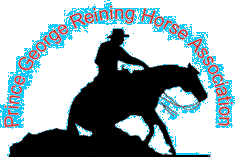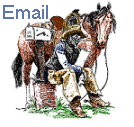|

HOME
HORSING AROUND
SHOW RESULTS
NEWSLETTER
CLINICS/RIDING SCHEDULE
RIDE AND SLIDE
SWAP & SELL
LINKS
SPONSORS
Spring Schooling Show
Gallery</a
Reiner Talk

View My
Guestbook
Sign My
Guestbook
|
Reiner Talk
Reining:is the fastest growing sport
in the Equine Industry. Reining is a judged competition designed to show the
athletic ability of a ranch type horse in the confines of a show arena. There
are ten NRHA approved patterns containing required maneuvers, including small
slow circles, large fast circles, flying lead changes, roll backs over the
hocks, 360 degree spins, and the very exciting sliding stops.
In reining all horses are created equal as they all begin the competition
with a score of 70. The horse can either plus or minus 1/2 to 1 1/2 points on
each maneuver in the reining pattern. The above statement is the basis of all
scoring with credit being given for smoothness, finesse, attitude, quickness
and authority of performing various maneuver, while using controlled speed,
which raises the degree of difficulty. Penalties of 0 to 5 points also accrue
for incorrect maneuvres, and going off pattern will result in the dreaded
Zero.
Another way all horses are created equal in reining is that reining horses
can be any breed, sex, color or size and are not required by the NRHA to be
registered with a breed association. The only requirement is that each horse
has a competition license that is issued by the NRHA before it can compete in
an NRHA Approved Event.
In 1998 Reining became the sixth discipline approved by the United States
Equestrian Team. In 1999 Reining made its debut at the Bayer/USET Festival of
Champions, the first time a western discipline has been included as a
competitive equestrian sport. Whizard Jac, owned by Bill and Dawn Pohl, &
rider Mike Flarida made history by winning the $100,00 Cosequin/USET Reining,
becoming the first horse and rider team to win a gold medal in reining. The
next goal is to be approved as an Olympic Event.....
Reining: Reining is the art of
guiding a horse with the reins held by the rider in one hand. It is not to be
confused with "raining" (although we do sometimes compete in
inclement weather) or "reigning" (although the reining horse reigns
supreme in the performance horse industry).
Reiner: Refers to a horse skilled in
the art of reining, a person who rides reining horses, or the magazine
published by NRHA for its members.
Open: You'll hear this word used in
several different ways - essentially it means "everyone's invited".
For instance, NRHA is "open" to all breeds. An "open"
class means anyone can enter. NRHA also has a "limited open" class
open to anyone who has not won over $5000.00.
Non Pro: Drop the second N and you have
"no pro". NRHA defines the non pro as any person who has not
directly or indirectly shown, trained, given lessons or assisted in the
training of a horse for remuneration - that means money! There are several
non pro divisions based on earnings: Non Pro, Intermediate Non Pro and
Limited Non Pro
The Pattern: There are 9 NRHA patterns.
A specific pattern is called for in each class. The contestants know which
pattern they will run well in advance of each class (whether or not they will
remember a pattern is something else altogether!). Each pattern contains
specific maneuvers: circles large and fast, circles small and slow, flying
lead changes, spins, sliding stops, rollbacks and back up.
Added Money, Purse: This means that a
specified amount of money is allotted to the class, then added to a
substantial portion of each contestant's entry fee. The total sum is the
"Purse" or the total amount of money paid out.
Order of Go, Draw: This sequence of
riders is chosen randomly. In a class as large as the Futurity, this is done
by computer. Each contestant may ride up to three horses in any given class,
so care is taken to separate this rider's horses. The "order of go"
or "draw" is posted or announced prior to each class.
The Ground: Reiner's talk incessantly
about the "ground" and with good reason. Good ground - a solid base
with a few inches of cushion on top - is essential to good reining.
Let's Drag: In order to maintain the
ground throughout a reining competition, it is groomed constantly or
"dragged".
On Deck, In the Hole: This does not
mean working on a sun tan or digging ditches. "On Deck" means you
are next in the arena. "In the Hole" means you are next "On
Deck" - your standard "order of go".
Cones: Does not refer to ice cream!
Three "cones" or markers are placed in the pen. following
instructions from the NRHA Handbook, the contestant runs the pattern as it
relates to these cones.
Leads: When running a circle the horse
extends the inside legs, both front and back, noticeably further than the
outside legs. If he's going to the right, he's leading with his right legs.
If he's going to the right, he's leading with his right legs.
Lead Changes: Each NRHA pattern calls
for several circles in each direction. How do you get from one direction to
another? You change leads, then go the other way. Of course, this is easier
said than done, but if your horse is "deadly", it won't be a
problem.
Deadly: This term refers to a horse's
ability to change leads, not his ability with a pistol. The
"deadly" horse never misses a lead and is a highly respected,
coveted animal.
Missed a Lead, Dropped a Lead, Out
Behind: any way you say it, this means trouble. The horse has started in the
incorrect lead (missed a lead), started out in the correct lead, then for any
number of reasons became out of sync (dropped a lead), or when changing
direction, only changed to the front inside leg (out behind - also known as
cross-firing). The key word is "out". Reiners who miss leads are
usually "out" of the money.
Spins, turnarounds, 360's: These terms
define a very exciting maneuver. The horse stands still, plants a back leg,
then pivots around it, in place with speed. Each NRHA pattern calls for four
consecutive spins in each direction. No matter how fast a horse gets to
cranking, he must be able to stop on a dime or it's penalty time.
Over spin, under spin, too many, too
few: In each pattern, there's a specific spot where the animal must start and
finish his turnaround. If he goes past this spot, it's an overspin. If he
stops short of the spot, it's an underspin. Over spins and underspins are penalized.
Too many or too few = too bad, thats a zero score for being off pattern.
Zero versus no score: You can earn a
zero if you use two hands, if your horse balks, runs away, jogs excessively,
or goes off pattern. Miniscule as it might be, a zero is a number and counts
as a score. The no score, which results from "wilful abuse" or
"illegal equipment" as described in the NRHA handbook means just
that. No score, no win, no place, no anything!
Whoa: This is the verbal command given
by the rider when a slide stop is called for. If all goes well and the horse
hears whoa instead of go, the reining horse will set the brakes and hopefully
leave tracks.
Tracks: Tracks resemble the number 11-
two straight parallel lines left in the dirt at the completion of the stop. If
the ground is good, and the horse is great, tracks will measure more then
twenty feet!
Rollback: If you were in the army, this
would be your standard about face. The rollback is a 180 degree turn at the
the completion of the slide stop.
Back up: This manuever occurs after a
slide stop. The horse is asked to move backwards over his slide tracks. The
horse must do this willingly - straight and clean. If he does it fast, he'll
score a bunch!
Arat ride: When murphy's law applies -
everything that can go wrong does!
Hooked: This is what happens when you
throw a leg over a reining horse. The reining horse is the most responsive
individual in the performance horse industry. A good one will grab, never let
go, and you'll be hooked - just like the rest of us! You'll be talking
"reiner talk" in no time!
Reining Buzzwords:
As with any industry, reining horse trainers used slang and code to
describe how their horses are working. Below is a list of the most popularly
used words and phrases.
Chasing the rein:
Inching the rein up the horse's neck during the lope. It's the horse's cue to
speed it up.
Deadly Leaded:
The natural ability to pick up or change leads while. Also a desirable trait.
Dragging the rear:
On one lead with the front legs and on the opposite lead with the hind legs.
Usually happens on a lead change. Also called "out behind" or
"crossfiring." Not a desirable trait.
Elevens:
The long, parallel tracks laid down by the horse's hind feet during a sliding
stop.
Fencing:
Stopping just before running into a fence. A training method for teaching
sliding stops.
Getting the face:
Having a horse lightly respond to the reins.
Melting into the ground:
When a horse quickly folds its hind legs under its body during a sliding
stop.
Rollback:
Turning the horse 180 degrees around from a standing position. Required in
all reining patterns.
Slides:
The long, rear-end dragging stops reining horses are famous for.
Slide plates:
Wide and long shoes that lengthen the horse's sliding stop.
Turn arounds:
What reiners refer to as spins.
By John Brasseaux
Feel free to:

PGRHA Mailing Address:
P/O Box 3005,
Prince George B.C.
V2N-4T7
|
|

